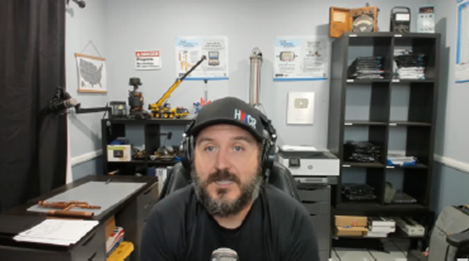Everybody expects content about refrigeration products to be boring.
That’s why the marketing team at Heatcraft Refrigeration Products wanted to flip the script in B2B marketing.
The division of Lennox International manufactures and sells refrigeration products such as walk-in, reach-in, and warehouse coolers, to restaurants, supermarkets, gas stations, and warehouses.
So, the marketing team creates engaging, unexpected, and personable content that helps Heatcraft stand apart from the competition.
Heatcraft’s content marketing director, Pete Grasso, and digital marketing director, Tim Fletcher, detailed the experience in their Content Marketing World presentation. Let’s go through their how-to and learn about the business results achieved.
Create compelling videos
Before Tim gets to the B2B, he shares a B2C example. Recently, he bought furniture that needed assembling. Instead of reading the printed instruction manual, he scanned a QR code from the manufacturer and watched a step-by-step assembly video.
In the B2B world, Heatcraft adopts a similar strategy, making short, compelling, and educational videos on how to install its refrigeration products.
“Like Reels and TikTok, we break our videos down into shorter, consumable videos,” Tim says.
Experienced technicians don’t need the content, but the newcomers do. “It’s all about making it relevant to the audience that you’re trying to reach,” Pete says.
Tim and Pete shared how to create relevant content:
- Solve your audience’s pain points. Heatcraft imagines scenarios and challenges faced by contractors in the field. It thinks about what junior installers need to learn and gets to making videos on those topics.
- Speak your audience’s language. For example, Heatcraft makes a product called a “unit cooler,” but contractors call it an “evaporator.” So, Heatcraft uses “evaporator” on its website, blog posts, and videos. “If we called it anything else, it wouldn’t be authentic to the contractor,” Tim says.
- Avoid corporate-speak. B2B content usually mimics corporate-speak. It’s expected. But Tim says, “Use the 90% to have fun, be engaging, be compelling, and you still have that 10% to get in the corporate-speak and make your boss happy.”
- Adopt a fresh approach. Pete says, “We don’t want to be the same as others. What’s better? A black-and-white PDF technical document with a lot of jargon on it or a voiced-over animated video that can explain the same thing in a much more compelling way?”
Start an in-house video operation
You don’t need a studio, high-end cameras, and a six-figure budget to create the unexpected in video. Pete and Tim use a do-it-yourself model with an assist from a freelance designer to create 20 to 30 videos per year. They write the scripts, create the storyboards, shoot the videos, and distribute them.
“We started with a $500 Lumix camera, some cheap microphones, and no external lighting,” Pete says. “As we started becoming more self-sufficient and producing really great content, leadership bought in.”
Pete and Tim now work from a studio at Heatcraft’s headquarters. They purchased a Blackmagic Pocket Cinema Camera 4K , the same kind used by reality TV shows. They bought drones.
Now, leadership goes to them for requests that go beyond marketing-related videos. “It’s nice that they bought in. They see the results, and they see the value of making great videos,” Pete says.
In the first two years of video publishing, Heatcraft generated over 1 million views. “For a B2C company, maybe that’s not big, but for a B2B manufacturing company, that’s huge for us,” Tim says.
Apply B2C social media strategies
Heatcraft also takes a more typical B2C approach to its social media marketing. Visit any of its social profiles and you’ll see that only 25% of its posts relate to Heatcraft products.
In three-fourths of the content, you’re likely to see videos, photos, and posts of team members and customers. Showing the people behind their products creates a stronger bond with customers and prospects, and it’s something their competitors don’t do.
“We also found that this was an awesome way to connect with the audience and gain market share through that highlighting of diversity, that family culture that we have, and showing the different ways that we work together,” Tim says.
Example: Family Always Matters
Heatcraft has a manufacturing initiative called “Quality Always Matters.” It uses the name in a hashtag, too. Pete and Tim reworded that initiative to promote the Heatcraft team — #PeopleAlwaysMatter and created this related video, titled “Families Always Matter,” featuring clips of the Johnson family working on the factory floor and letting viewers see the people behind the products.
Since adopting the B2C mindset a year ago, Heatcraft’s follower count on LinkedIn and Facebook has increased by 34%, and engagement has jumped from 3.1% to 5.4%. In addition, Heatcraft’s following is 10 times larger than its closest competitors.
Leverage niche influencers
At Content Marketing World, Onalytica’s Ashley Zeckman covered the six influencer types in her presentation — one of which is the niche expert. These influencers have smaller audiences but hyper-relevant content.
Pete and Tim recommend spending time to research niche experts in your industry. “It’s going to take a lot of time on the front end to make sure it’s the right fit. Don’t choose to engage with the first influencer that you come across with a large audience,” Tim says.
They studied prospective influencers to ensure that their audiences matched Heatcraft’s target audience. They also observed how well the influencers interacted with their audience.
To reach the contractor audience, they partnered with Chris Stephens of HVACR VIDEOS.

Pete shares that Chris didn’t set out to be an influencer but started filming service calls to educate the technicians in his company on the proper way to do things. “He made his YouTube channel live, and it just kind of exploded because now you’ve got refrigeration people from all over watching it,” Pete says.
Chris creates educational videos about Heatcraft products. “He’s done a lot of videos that’s gotten our message out there, but it’s coming from someone who’s authentic and speaking to his peers,” Pete says.
In the first year, Chris’ videos generated 400,000 views and 250 to 300 comments per video. While the high view count is impressive, Heatcraft finds the audience interaction more attractive.
Chris’ work also gathers input. “We’re finding out about issues in the wild, about the products that we can then bring to our engineers, to our quality teams, and our product managers to actually improve products based on these conversations that are happening,” Tim says.
Are you ready to flip the boring script?
Pete and Tim found a way to make content for the manufacturer of refrigeration products engaging and unexpected. They shifted to video content and worked with niche influencers. And they did it all by focusing less on the products and more on the people who make and use those products.
So, as you adopt a B2C approach for your B2B brand, keep Tim’s advice in mind: “Focus on your customer, not your own greatness.”
HANDPICKED RELATED CONTENT:
Cover image by Joseph Kalinowski/Content Marketing Institute



